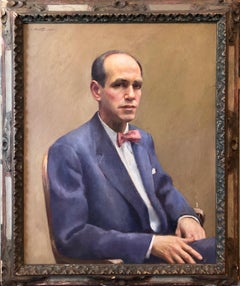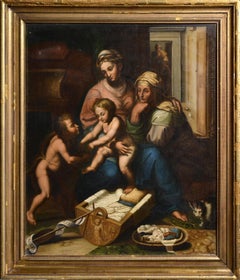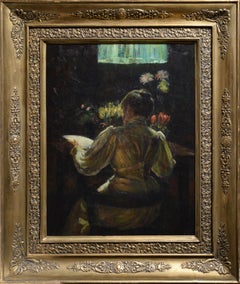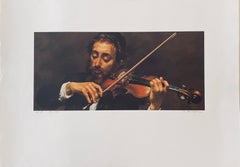Itshak Holtz Art
to
1
1
1
Overall Height
to
Overall Width
to
1
1
1
6,886
3,210
2,514
1,217
1
1
1
1
Artist: Itshak Holtz
Itzhak Holtz (Judaica Master) Oil Painting Portrait John Sloan Ashcan Artist WPA
By Itshak Holtz
Located in Surfside, FL
Oil Painting Portrait of Ashcan Artist John Sloan. Signed I. Holtz.
The youngest of four children, Holtz was born and spent his early childhood in Skierniewice, Poland, a small town near Warsaw. His father was a hat maker and a furrier. In 1935, prior to World War II, when Holtz was ten years old, his family moved to Jerusalem, Israel, where they settled in the Geula neighborhood near Meah Shearim.
Itzhak Holtz's passion for art began early. When he was five years old, in Poland, his father first drew a picture of a horse and sled in the snow for him. The young Holtz looked at the drawing and studied it in wonderment. From that moment on, Holtz remembers, he constantly begged his father to draw for him. His enthusiasm for art grew and Holtz longed to study art. In 1945, he enrolled at the Bezalel Academy of Art and Design in Jerusalem, where he primarily studied lettering and poster work in a program geared toward commercial art Holtz became interested in painting, prompting him to move to New York City in 1950 to study at the Art Students League of New York under Robert Brackman and Harry Sternberg, and then at the National Academy of Design under Robert Philipp.
Holtz has stated that his artwork, which primarily but not exclusively, depict scenes of Jewish spirituality and tradition, is driven by his Orthodox Jewish beliefs: "You have to live that religious life to fully capture it on canvas." He has been classified in the school of genre painting, often depicting street scenes of ordinary people in everyday Jewish life in the back alleys and markets of Jerusalem neighborhoods such as Me'ah Shearim and Geula; and in New York neighborhoods and hamlets such as Monsey, Boro Park and Williamsburg. Along with street scenes, his work includes portraits of scribes, tailors, cobblers and fishmongers, and images such as shtetls, lighthouses, and wedding scenes. He started out painting mostly portraits in order to support his family, before expanding to include street scenes. His beloved subject matter is painting scenes of Jewish life, his childhood memories when his mother took him along shopping for the Sabbath to the markets of Meah Shearim, has left a deep impression on him and influenced many of his works. Holtz has experimented in the abstract, but then reverted to representational and figurative art to which he devoted himself exclusively. His Israeli street scenes are said to combine “an affectionate recollection of the past with the brilliance of the color of modern Israel.”
Holtz has stated that he struggled at first when he arrived to the USA because of financial reasons and because he only knew Polish, Yiddish and Hebrew, but then made good ties with his instructor who greatly influenced him Robert Philipp who helped him make friends and referred him to paint portraits.
Examples of Holtz's work throughout the years include: Yerusalem Wedding (2010), depicting a Chuppa in Jerusalem on early evening, oil on canvas; The Funeral(1966), depicting five stoic Hasidim carrying a body on a bier over to a gravesite, with the people behind them crying, in charcoal on paper and oil on canvas; Rejoicing (1974), an image of religious men dancing, in felt pen and marker on paper; and the oil painting Shamash Learning in Shul (2003), a portrait of a pious Jew studying the Talmud inside a claustrophobic synagogue scene.
Throughout the years Holtz has created hundreds of works in many art mediums, including, genre scenes, portraits, still lifes and landscape scenery, his works are sought after by art collectors worldwide, and he has been called the greatest living Jewish artist. It is said that no artist ever explored the Jewish subject like Holtz. Today some of his oil paintings have been commanding over $100,000.
Holtz creates his scenes after researching locations, and often uses locals as models. He paints slowly and with great care, but with a swift Impressionistic style. The people in his portraits and scenes are generally more cheerful and optimistic than standard portraits of Hassidic individuals. He paints oils and watercolors, and also does felt pen, pastel, marker, ink and charcoal drawings, as well as woodcuts. His oil paintings typically have a brown hue, while his work with felt pen is often in sepia tones, and on some of his works he used very bright colors, with a strong emphasis on the interplay of light and shadow. He is heavily influenced by the ancient staircases and alleyways of Jerusalem, with its modest religious population, which has made a strong impression on him in his youth, the streets of Tzfat, and the works of Rembrandt, Johannes Vermeer and Peter Bruegel, as well as Jewish artists Moritz Daniel Oppenheim...
Category
1940s Realist Itshak Holtz Art
Materials
Canvas, Oil
Related Items
Holy Family with St Elizabeth and Young John Baptist 19th century Oil Painting
Located in Stockholm, SE
This tender depiction of the Holy Family represents a subject which was central to Raphael's oeuvre. The painting is based on the famous panel by Giulio Romano, called Madonna della ...
Category
Late 19th Century Realist Itshak Holtz Art
Materials
Canvas, Wood, Oil
Homey Scene with Flowers and Lady Reading 1897 Norwegian Oil Painting
Located in Stockholm, SE
The signature at the bottom right with the date and ink inscriptions on the stretcher lead us to the Norwegian painter Henrik Asor Hansen (1862 - 1929). In the center of the scene is...
Category
Late 19th Century Realist Itshak Holtz Art
Materials
Canvas, Wood, Cotton Canvas, Oil
"Raquel" Original Oil and Acrylic Painting
Located in Denver, CO
"Raquel" by Conrado López is a delicate yet expressive 2023 artwork, utilizing acrylic and oil on a canvas sized at 5 x 5 inches (12.70 x 12.70 cm). With the addition of its frame, t...
Category
2010s Realist Itshak Holtz Art
Materials
Oil, Canvas, Acrylic
Gerberas - Contemporary Figurative Oil Painting, Realistic Little Girl Portrait
By Kamil Lisek
Located in Salzburg, AT
KAMIL LISEK (born in 1980) Studied under the guidance of prof. Maciej Świeszewski at the faculty of painting at the Academy of Fine Arts in Gdansk. He graduated with distinction obta...
Category
2010s Realist Itshak Holtz Art
Materials
Oil, Linen, Canvas
H 39.38 in W 27.56 in D 0.79 in
"Sergio in the Pool" Original Oil and Acrylic Painting
Located in Denver, CO
Conrado López presents "Sergio in the Pool," a notable 2023 composition rendered in acrylic and oil on a canvas measuring 116 x 89 cm (45.67 x 35.04 inches). This primary market artw...
Category
2010s Realist Itshak Holtz Art
Materials
Canvas, Oil, Acrylic
Spanish school XX century Saint Pancras oil on canvas painting
Located in Barcelona, Barcelona
Oil measures 55x46 cm.
Frameless.
Category
1990s Realist Itshak Holtz Art
Materials
Oil, Canvas
Red Bandana - XXI Century, Contemporary Figurative Oil Painting, Portrait
By Tomasz Kozlowski
Located in Warsaw, PL
Tomasz Kozlowski is a Polish artist, born in 1983 in Piotrkow Trybunalski, He lives and works in Lodz. He studied at the faculty of textiles and fashion of the Fine Arts School in Lo...
Category
21st Century and Contemporary Realist Itshak Holtz Art
Materials
Canvas, Oil
Oil Painting / Abstract versus Figurative Art / Figurative Art / Human Figure /
By Bruce Adams
Located in Buffalo, NY
Bruce Adams was a painter, art educator, and writer. Born in Buffalo, N.Y., in 1952, he received a B.S. in 1976 and an M.A. in 1983 from Buffalo State College. Adams’s work is includ...
Category
1980s Realist Itshak Holtz Art
Materials
Canvas, Oil
Portrait of Old Woman 1893 by Famous Russian Master Oil Painting on Canvas Frame
Located in Stockholm, SE
Attributed by Nikolay Alekseyevich Kasatkin (1859 - 1930). In this touching artwork, the artist perfectly conveyed the character of the old woman, who has seen a lot in her life. The hands, tired out and riddled with veins, lie helplessly on the knees. Her slouched body tells us about the load of years lived. The painter skillfully conveys a sense of wisdom, kindness, and humility through her wrinkled face and detached gaze. The painting exudes warmth with a subtle touch of sadness and reflection on a life lived. Thanks to moderately contrasting colors, the portrait comes to life and shows us the depth of the artist's intention. Kasatkin not only continued the traditions of the best masters of portraiture in Russia in the 19th century, but also introduced new principles into it. He sought to display on canvas not only the external features of a person, but also to demonstrate his spiritual world. Antique oil painting on canvas, signed bottom left, framed.
Size app.: 68.5 x 52.3 cm (roughly 27 x 20.6 in), frame is 80.5 x 63.5 cm (roughly 31.7 x 25 in). Very good condition, very well preserved recently conserved condition with minimal wear (notice few micro losses here and there). Please study good resolution images for cosmetic condition. In person actual painting may appear darker or brighter than in our pictures, strictly depending on sufficient light in your environment. Weight of app. 5.4 kg is going to measure 8 kg packed for shipment.
Nikolay Alekseyevich Kasatkin (1859 - 1930) was a Russian painter, considered to be one of the founders of Social Realism in Russia. From 1873 to 1883 he studied at the Moscow School of Painting, Sculpture and Architecture with Vasily Perov and Illarion Pryanishnikov. Upon graduating, he received a medal for his painting "Beggars at the Church Door". In 1891, he began exhibiting with the Peredvizhniki and, from 1894 to 1917, was a teacher at his alma mater. For thirty years, beginning in 1883, he worked with Ivan Sytin, providing illustrations for his popular almanac/calendars and teaching lithography. He also contributed The Great Reform, an encyclopedia that celebrated the fiftieth anniversary of the Emancipation (1861), and a collection called "Russian History in Pictures". In 1903, he became a member of the Imperial Academy of Arts. He participated in the Exposition Universelle (1900), where he won a silver medal, and the Louisiana Purchase Exposition (1904), among others. In 1923, following the Civil War, he was named the first "People's Artist of the Republic" and became a member of the AKhRR (Association of Artists). He is considered to be one of the forerunners of Socialist Realism in the arts and was sometimes called the "Gorky of Painters". In 1956, the Soviet Union honored him with a 40 kopeck commemorative postage stamp. In 1971, his painting of a female mine worker...
Category
Late 19th Century Realist Itshak Holtz Art
Materials
Canvas, Wood, Oil
"Detail of Alba" Original Oil and Acrylic Painting
Located in Denver, CO
Conrado López's "Detail of Alba," a 2023 primary market artwork, is an exemplary display of the artist's proficiency in blending acrylic and oil on canvas. This original 5 x 5 inches...
Category
2010s Realist Itshak Holtz Art
Materials
Oil, Canvas, Acrylic
"Pretty In Pink", Hans Amis, Realistic Portrait, Flowers, Original Oil, 40x30 in
By Hans Amis
Located in Dallas, TX
"Pretty in Pink" by Hans Amis, also known as An He, is an original oil on canvas portrait painting that measures 40x30 in. in a gold ornate frame. This period portrait depicts a carefree young woman with brown hair picking...
Category
Early 2000s Realist Itshak Holtz Art
Materials
Canvas, Oil
"Alba's Mirror" Original Oil and Acrylic Painting
Located in Denver, CO
Please note: If you live outside of the United States, we will ship the painting in a tube.
Presenting "Alba's Mirror" by Conrado López, an original handmade painting created in 20...
Category
2010s Realist Itshak Holtz Art
Materials
Oil, Canvas, Acrylic
Previously Available Items
"The Violinist" Judaica Jewish Lithograph Signed Itshak Holtz
By Itshak Holtz
Located in Surfside, FL
The youngest of four children, Holtz was born and spent his early childhood in Skierniewice, Poland, a small town near Warsaw. His father was a hat maker and a furrier. In 1935, prior to World War II, when Holtz was ten years old, his family moved to Jerusalem, Israel, where they settled in the Geula neighborhood near Meah Shearim.
Itzhak Holtz...
Category
20th Century Realist Itshak Holtz Art
Materials
Lithograph
Itzhak Holtz (Judaica Master) Oil Painting Portrait John Sloan Ashcan Artist WPA
By Itshak Holtz
Located in Surfside, FL
Oil Painting Portrait of Ashcan Artist John Sloan. Signed I. Holtz.
The youngest of four children, Holtz was born and spent his early childhood in Skierniewice, Poland, a small town near Warsaw. His father was a hat maker and a furrier. In 1935, prior to World War II, when Holtz was ten years old, his family moved to Jerusalem, Israel, where they settled in the Geula neighborhood near Meah Shearim.
Itzhak Holtz's passion for art began early. When he was five years old, in Poland, his father first drew a picture of a horse and sled in the snow for him. The young Holtz looked at the drawing and studied it in wonderment. From that moment on, Holtz remembers, he constantly begged his father to draw for him. His enthusiasm for art grew and Holtz longed to study art. In 1945, he enrolled at the Bezalel Academy of Art and Design in Jerusalem, where he primarily studied lettering and poster work in a program geared toward commercial art Holtz became interested in painting, prompting him to move to New York City in 1950 to study at the Art Students League of New York under Robert Brackman and Harry Sternberg, and then at the National Academy of Design under Robert Philipp.
Holtz has stated that his artwork, which primarily but not exclusively, depict scenes of Jewish spirituality and tradition, is driven by his Orthodox Jewish beliefs: "You have to live that religious life to fully capture it on canvas." He has been classified in the school of genre painting, often depicting street scenes of ordinary people in everyday Jewish life in the back alleys and markets of Jerusalem neighborhoods such as Me'ah Shearim and Geula; and in New York neighborhoods and hamlets such as Monsey, Boro Park and Williamsburg. Along with street scenes, his work includes portraits of scribes, tailors, cobblers and fishmongers, and images such as shtetls, lighthouses, and wedding scenes. He started out painting mostly portraits in order to support his family, before expanding to include street scenes. His beloved subject matter is painting scenes of Jewish life, his childhood memories when his mother took him along shopping for the Sabbath to the markets of Meah Shearim, has left a deep impression on him and influenced many of his works. Holtz has experimented in the abstract, but then reverted to representational and figurative art to which he devoted himself exclusively. His Israeli street scenes are said to combine “an affectionate recollection of the past with the brilliance of the color of modern Israel.”
Holtz has stated that he struggled at first when he arrived to the USA because of financial reasons and because he only knew Polish, Yiddish and Hebrew, but then made good ties with his instructor who greatly influenced him Robert Philipp who helped him make friends and referred him to paint portraits.
Examples of Holtz's work throughout the years include: Yerusalem Wedding (2010), depicting a Chuppa in Jerusalem on early evening, oil on canvas; The Funeral(1966), depicting five stoic Hasidim carrying a body on a bier over to a gravesite, with the people behind them crying, in charcoal on paper and oil on canvas; Rejoicing (1974), an image of religious men dancing, in felt pen and marker on paper; and the oil painting Shamash Learning in Shul (2003), a portrait of a pious Jew studying the Talmud inside a claustrophobic synagogue scene.
Throughout the years Holtz has created hundreds of works in many art mediums, including, genre scenes, portraits, still lifes and landscape scenery, his works are sought after by art collectors worldwide, and he has been called the greatest living Jewish artist. It is said that no artist ever explored the Jewish subject like Holtz. Today some of his oil paintings have been commanding over $100,000.
Holtz creates his scenes after researching locations, and often uses locals as models. He paints slowly and with great care, but with a swift Impressionistic style. The people in his portraits and scenes are generally more cheerful and optimistic than standard portraits of Hassidic individuals. He paints oils and watercolors, and also does felt pen, pastel, marker, ink and charcoal drawings, as well as woodcuts. His oil paintings typically have a brown hue, while his work with felt pen is often in sepia tones, and on some of his works he used very bright colors, with a strong emphasis on the interplay of light and shadow. He is heavily influenced by the ancient staircases and alleyways of Jerusalem, with its modest religious population, which has made a strong impression on him in his youth, the streets of Tzfat, and the works of Rembrandt, Johannes Vermeer and Peter Bruegel, as well as Jewish artists Moritz Daniel Oppenheim, Tully Filmus, Leonid Pasternak and Isidor Kaufmann have had a strong influence on him. He has said that realism is the best way he can express himself.
John French Sloan (August 2, 1871 – September 7, 1951) was an American painter and etcher. He is considered to be one of the founders of the Ashcan school of American art. He was also a member of the group known as The Eight. He is best known for his urban genre scenes and ability to capture the essence of neighborhood life in New York City, often observed through his Chelsea studio window. Sloan has been called "the premier artist of the Ashcan School who painted the inexhaustible energy and life of New York City during the first decades of the twentieth century"and an "early twentieth-century realist painter who embraced the principles of Socialism and placed his artistic talents at the service of those beliefs." In the fall of 1884 he enrolled at the prestigious Central High School in Philadelphia, where his classmates included William Glackens and Albert Barnes. In 1892, he began working as an illustrator in the art department of The Philadelphia Inquirer. Later that same year, Sloan began taking evening classes at the Pennsylvania Academy of the Fine Arts under the guidance of the realist Thomas Anshutz.
In 1892, Sloan met Robert Henri, a talented painter and charismatic advocate of artistic independence who became his mentor and closest friend. Henri encouraged Sloan in his graphic work and eventually convinced him to turn to painting. They shared a common artistic outlook and in the coming years promoted a new form of realism, known as the "Ashcan school" of American art. In 1893, Sloan and Henri founded the short-lived Charcoal Club together, whose members would also include Glackens, George Luks, and Everett Shinn.
Sloan participated in the landmark 1908 exhibition at the Macbeth Galleries of a group that included four other artists from the Philadelphia Charcoal Club (Henri, Glackens, Luks and Shinn) as well as three artists who worked in a less realistic, more impressionistic style, Maurice Prendergast, Ernest Lawson, and Arthur B. Davies. The group was afterward collectively known as "The Eight." In 1922 he organized an exhibition of work by Native American artists at the Society of Independent Artists in New York. He also championed the work of Diego Rivera, whom he called "the one artist on this continent who is in the class of the old masters." The Society of Independent Artists, which Sloan had co-founded in 1916, gave Rivera and José Clemente Orozco their first showing in the United States in 1920.
In American Visions, the critic Robert Hughes praised Sloan's art for "an honest humaneness, a frank sympathy, a refusal to flatten its figures into stereotypes of class misery ... He saw his people as part of larger totality, the carnal and cozy body of the city itself." In American Painting from the Armory Show to the Depression, art historian Milton Brown called Sloan "the outstanding figure of the Ash Can School." To his friend, the painter John Butler Yeats...
Category
1940s Realist Itshak Holtz Art
Materials
Canvas, Oil
"Three Klezmer Musicians" Judaica Jewish Lithograph Signed Itshak Holtz
By Itshak Holtz
Located in Surfside, FL
The youngest of four children, Holtz was born and spent his early childhood in Skierniewice, Poland, a small town near Warsaw. His father was a hat maker and a furrier. In 1935, prior to World War II, when Holtz was ten years old, his family moved to Jerusalem, Israel, where they settled in the Geula neighborhood near Meah Shearim.
Itzhak Holtz...
Category
1960s Realist Itshak Holtz Art
Materials
Lithograph
Itshak Holtz art for sale on 1stDibs.
Find a wide variety of authentic Itshak Holtz art available for sale on 1stDibs. You can also browse by medium to find art by Itshak Holtz in canvas, fabric, oil paint and more. Not every interior allows for large Itshak Holtz art, so small editions measuring 30 inches across are available. Customers who are interested in this artist might also find the work of Dmitriy Krestniy, Doris Zinkeisen, and Adrienne Stein. Itshak Holtz art prices can differ depending upon medium, time period and other attributes. On 1stDibs, the price for these items starts at $8,000 and tops out at $8,000, while the average work can sell for $8,000.




